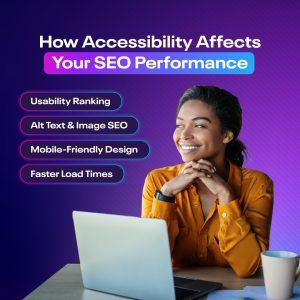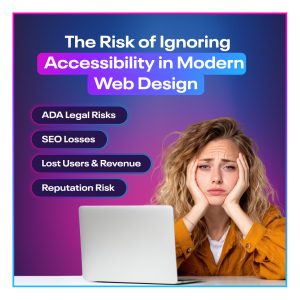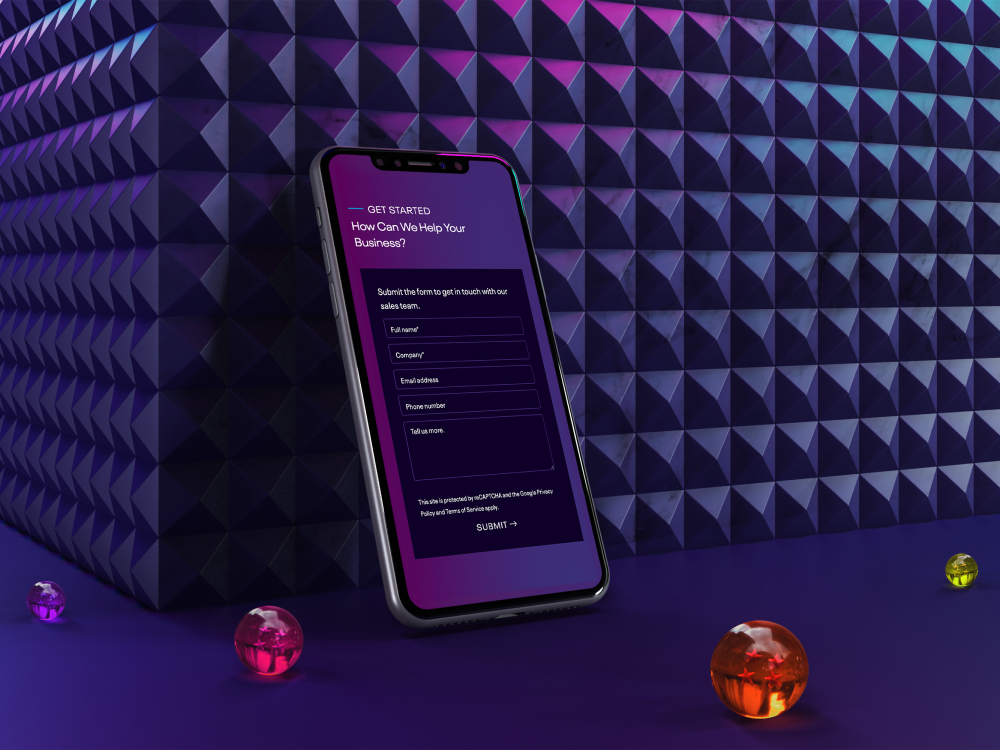INSIGHTS
Website accessibility is often viewed as a legal requirement or a technical checklist. However, accessibility does much more than help you meet compliance. It directly influences how people interact with your site, how search engines rank it, and whether visitors choose to stay and engage.
Designing with accessibility in mind improves usability for all visitors and also sends strong quality signals to search engines like Google. In this article, we’ll explore how accessibility supports SEO, enhances user experience, and strengthens customer retention.
What Is Website Accessibility?
Website accessibility means designing and developing your site so that all users can navigate and interact with it, regardless of ability. This includes people who rely on assistive technologies such as screen readers, keyboard-only navigation, voice commands, or screen magnifiers.
Accessibility is guided by standards like the Web Content Accessibility Guidelines (WCAG), which outline best practices for contrast, navigation, readability, and more. Adding alt text to images, labeling forms correctly, and creating logical content structures are just a few of the ways accessibility is implemented. While it benefits users with disabilities, accessibility also improves usability for everyone. A more accessible site performs better on mobile devices, supports users in different environments, and creates a smoother experience for all visitors.
What Is Search Engine Optimization (SEO)?
Search engine optimization, or SEO, is the process of improving your website so that it ranks higher in search results for keywords related to your business. The goal is to increase visibility, drive more traffic to your site, and convert visitors into customers.
SEO includes a range of strategies such as content optimization, mobile responsiveness, fast loading times, and clean code. These elements help search engines better understand and index your site, which increases your chances of appearing in top search results.
Many SEO best practices overlap with accessibility. When your site is easier for users to navigate and understand, it is also easier for search engines to interpret and rank. This shared focus on clarity and structure creates a powerful connection between accessibility and SEO.
Why Does Website Accessibility Matter?
Website accessibility matters because it ensures that all users, regardless of ability, can fully experience and interact with your content. It is a core part of building an inclusive digital presence that respects the needs of people with disabilities, older adults, and anyone facing temporary or situational limitations.
Beyond inclusivity, accessibility improves the overall usability of your site. Clear navigation, readable text, properly labeled elements, and responsive design make it easier for all users to engage with your content. These improvements lead to longer site visits, higher conversion rates, and greater customer satisfaction.
How Accessibility Affects Your SEO Performance
Accessibility and SEO go hand in hand. While search engine optimization focuses on improving visibility in search results, many of the same principles also enhance accessibility. When your website is easier for users to navigate, understand, and engage with, it also becomes easier for search engines to crawl, index, and rank. Below are some of the key ways accessibility directly influences SEO performance.
Usability as a Ranking Factor
Search engines prioritize websites that offer a positive user experience. An accessible site is easier to use, especially for people with disabilities or those browsing on mobile devices. Improved usability leads to longer visit durations, more interaction, and better engagement signals, all of which contribute to stronger SEO performance.
Semantic HTML & Structured Data
Using semantic HTML helps define the meaning of each element on a page, making your content clearer to both users and search engines. Structured data adds additional context that helps Google understand what your site is about. Together, they improve crawlability, support accessibility features like screen readers, and increase your chances of appearing in rich search results.
Alt Text & Image SEO
Alternative text (also known as alt text) is essential for screen reader users, but it also helps search engines understand the content of your images. Well-written alt text improves image indexing and can boost your visibility in image search results. It’s a small detail that plays a big role in both accessibility and SEO.
Lower Bounce Rates
When users land on a site that is confusing or hard to navigate, they tend to leave quickly. Accessible websites are easier to use, which reduces frustration and encourages visitors to stay longer. This lowers your bounce rate, which is a positive signal to search engines that your content is relevant and valuable.
Mobile-Friendly Design
Accessibility best practices often overlap with mobile responsiveness. Features like scalable text, touch-friendly buttons, and simplified navigation not only support users with disabilities but also improve the experience for mobile visitors. Since Google prioritizes mobile-first indexing, an accessible and mobile-friendly design can significantly boost your SEO rankings.
Improved Crawlability
Search engines rely on clean, structured code to crawl and index your site properly. Accessible websites often follow best practices like logical heading hierarchies, descriptive links, and proper tagging. These elements help crawlers understand your content, improving how your site appears in search results.
Readable Content Structure
An accessible site uses clear headings, organized sections, and consistent formatting to guide users through the page. This structure helps visitors find what they need faster and also helps search engines understand your content hierarchy. Readable content keeps users engaged and supports better indexing across your site.
Faster Load Times
Accessibility features like streamlined layouts, optimized images, and minimal animations can contribute to faster page speed. Since site speed is a confirmed ranking factor, these improvements benefit both usability and SEO. Faster load times also reduce bounce rates and keep users on your site longer.
Voice Search Compatibility
As more users rely on voice assistants to browse the web, accessible websites have an edge. Clean code, clear language, and properly labeled elements make it easier for voice search tools to interpret and deliver your content. Optimizing for accessibility also helps your site stay competitive as search behavior continues to evolve.
Why Accessibility Improves Customer Retention
Attracting visitors to your website is only part of the equation. What drives long-term business growth is keeping them engaged, converting them into customers, and encouraging them to return. Website accessibility plays a key role in that process.
When your site is easy to use and inclusive of everyone’s needs, it creates a more welcoming experience. This not only helps users feel seen and supported but also encourages them to come back. Here’s how accessibility directly contributes to stronger customer retention.
Builds Trust With a Wider Audience
An accessible website shows that your business values inclusion and cares about all users. People are more likely to trust and support brands that consider their needs. When your site accommodates everyone, regardless of ability, it opens the door to a broader and more loyal customer base.
Reduces Frustration & Increases Usability
When users can’t navigate your site easily or access key information, they’re likely to leave and not return. Accessibility improvements like clear menus, keyboard navigation, and readable fonts make it easier for all users to find what they need. This reduces frustration and leads to a smoother, more satisfying experience.
Creates a Better Experience for All Users
Good accessibility practices benefit everyone, not just users with disabilities. Whether someone is using a screen reader or browsing with one hand on a phone, clean design, clear content, and intuitive functionality make your site easier to use in various situations. A better experience keeps users engaged and more likely to return.
Supports Brand Reputation & Loyalty
When your website consistently delivers a positive, accessible experience, it reflects well on your brand. Users notice when businesses go the extra mile to make their digital presence inclusive. This strengthens your reputation and builds loyalty, especially among customers who often feel overlooked online.
The Risk of Ignoring Accessibility in Modern Web Design
Accessibility is no longer optional. In today’s digital landscape, failing to make your website inclusive can lead to serious consequences, including legal action and lost customers. Businesses that ignore accessibility not only alienate users but also risk damaging their search visibility, brand reputation, and revenue. Below are some of the most common and costly outcomes of neglecting accessibility.
 Legal Risks & ADA Non-Compliance
Legal Risks & ADA Non-Compliance
Under the Americans with Disabilities Act (ADA), businesses in the United States are required to meet certain accessibility standards. Non-compliant websites may face lawsuits, financial penalties, and public scrutiny. Investing in accessibility helps you avoid legal issues and shows that your business takes compliance seriously.
Lost SEO Opportunities & Rankings
Ignoring accessibility often means overlooking important SEO best practices. Poor site structure, missing alt text, and inaccessible navigation can prevent search engines from properly indexing your content. This results in lower rankings, less traffic, and fewer opportunities to attract new customers through organic search.
Excluded Users & Missed Revenue
When your site isn’t accessible, you’re turning away potential customers who can’t use it effectively. This includes people with disabilities, older adults, and mobile device users. Over time, excluding these audiences leads to missed sales, lower engagement, and a smaller customer base.
Damage to Brand Image & Credibility
A website that is difficult or impossible to use can reflect poorly on your brand. Users who feel frustrated or excluded are unlikely to return or recommend your business. In contrast, an accessible site shows professionalism, care, and commitment to a positive customer experience, all of which strengthen your reputation.
What to Look for in an Accessible Website Design Partner
If you’re ready to prioritize accessibility on your website, choosing the right design partner is essential. Not all web agencies have the knowledge or processes to build fully accessible, SEO-friendly websites. It’s important to look for an Orlando web design agency that combines compliance expertise with technical skill, user experience, and long-term support.
Experience With WCAG & ADA Standards
A qualified web design partner should be familiar with the Web Content Accessibility Guidelines (WCAG) and know how to meet ADA compliance requirements. They should be able to interpret these standards and apply them to real-world website design, ensuring that every element supports accessibility from the start.
Technical SEO Knowledge & Front-End Expertise
Accessibility and SEO go hand in hand. Look for a team with strong front-end development skills and an understanding of how code structure, semantic markup, and responsive design impact both user experience and search rankings. A partner with this dual focus can build a website that performs well on every level.
Ability to Run Accessibility Audits & Fix Issues
Your design partner should have the tools and processes to assess your website’s accessibility. This includes performing detailed audits, identifying barriers, and fixing them quickly. Whether you’re building a new site or improving an existing one, they should provide clear recommendations and technical solutions.
Ongoing Support for Updates & Compliance
Accessibility is not a one-time task. Your partner should offer ongoing support to keep your site compliant as guidelines evolve, content changes, or new features are added. This includes regular check-ins, monitoring tools, and fast responses when updates are needed.
Schedule a Consultation with an Orlando Web Design Agency
Website accessibility is more than just a requirement. It is an essential part of creating a user-friendly, high-performing website that supports both customer experience and search engine optimization. At Brandcoders, we build custom websites that are fully accessible, ADA-compliant, and optimized for SEO from the ground up.
As a leading Orlando web design agency and Orlando search engine optimization (SEO) agency, we understand how accessibility, performance, and rankings work together to drive results. If you’re ready to reach more users, strengthen your online presence, and stay ahead of digital standards, our team is here to help. Schedule a consultation today and discover how accessibility can elevate your entire website strategy.
Talk to a sales agent today to jump start your project.
Call (407) 992-8877



